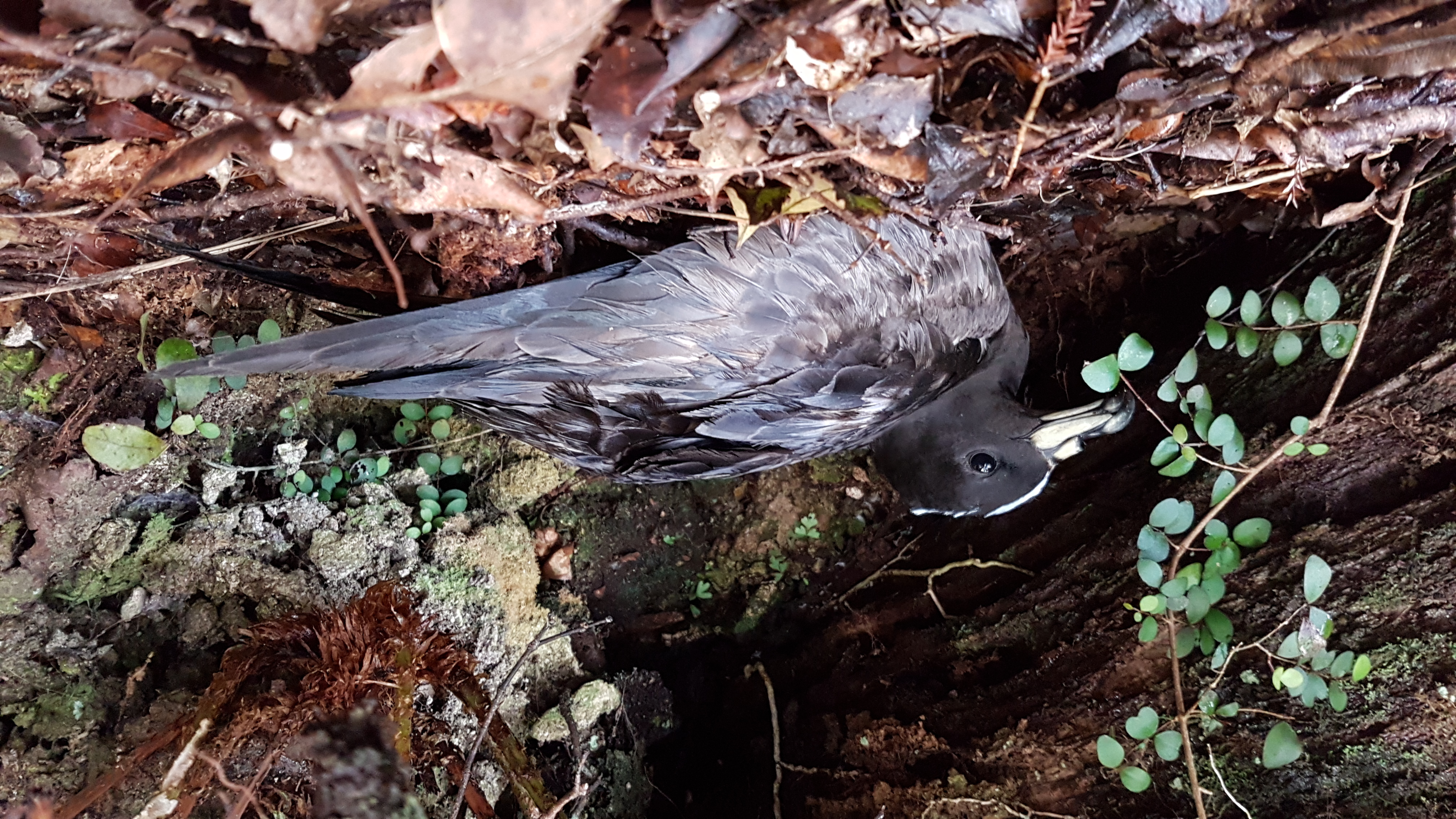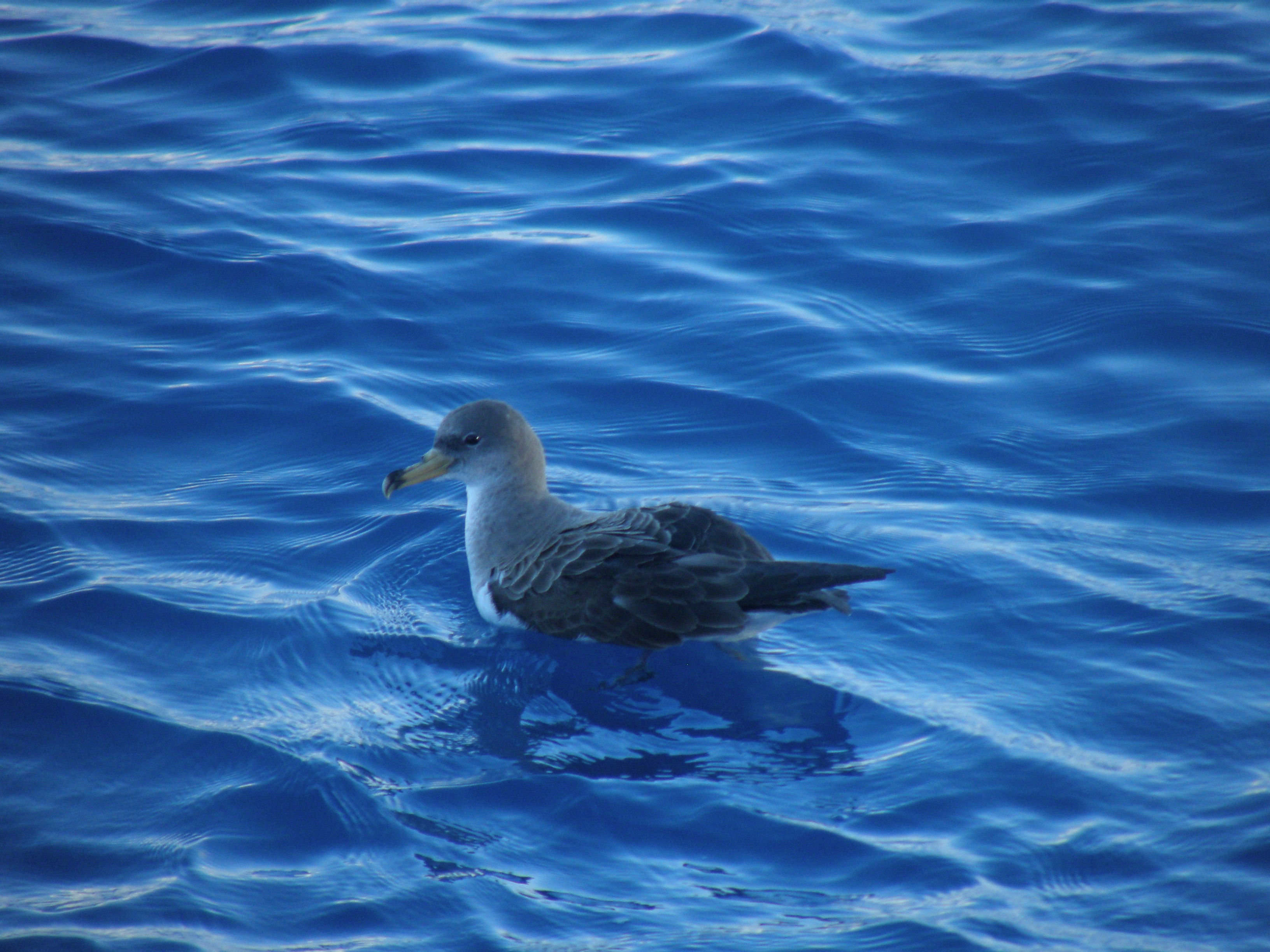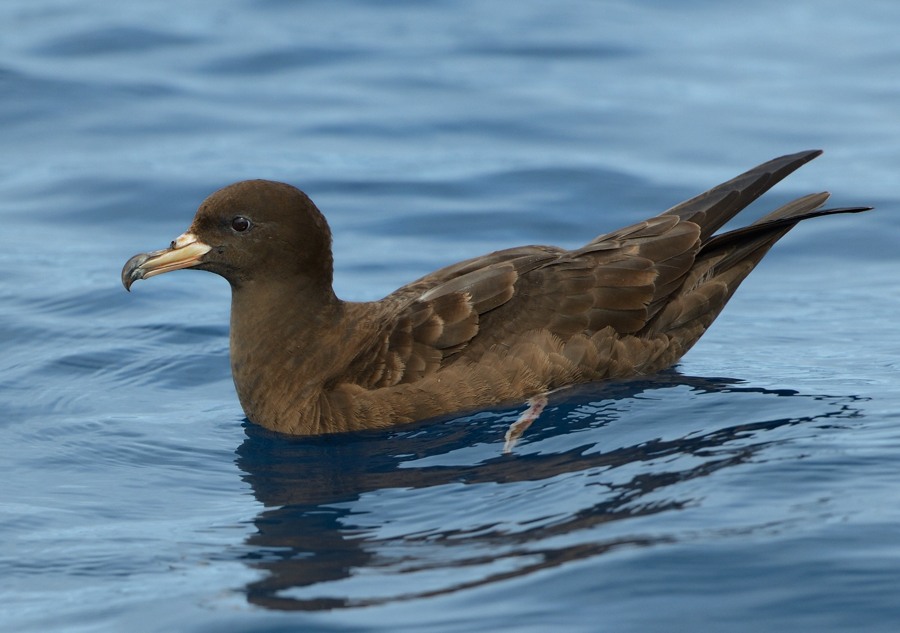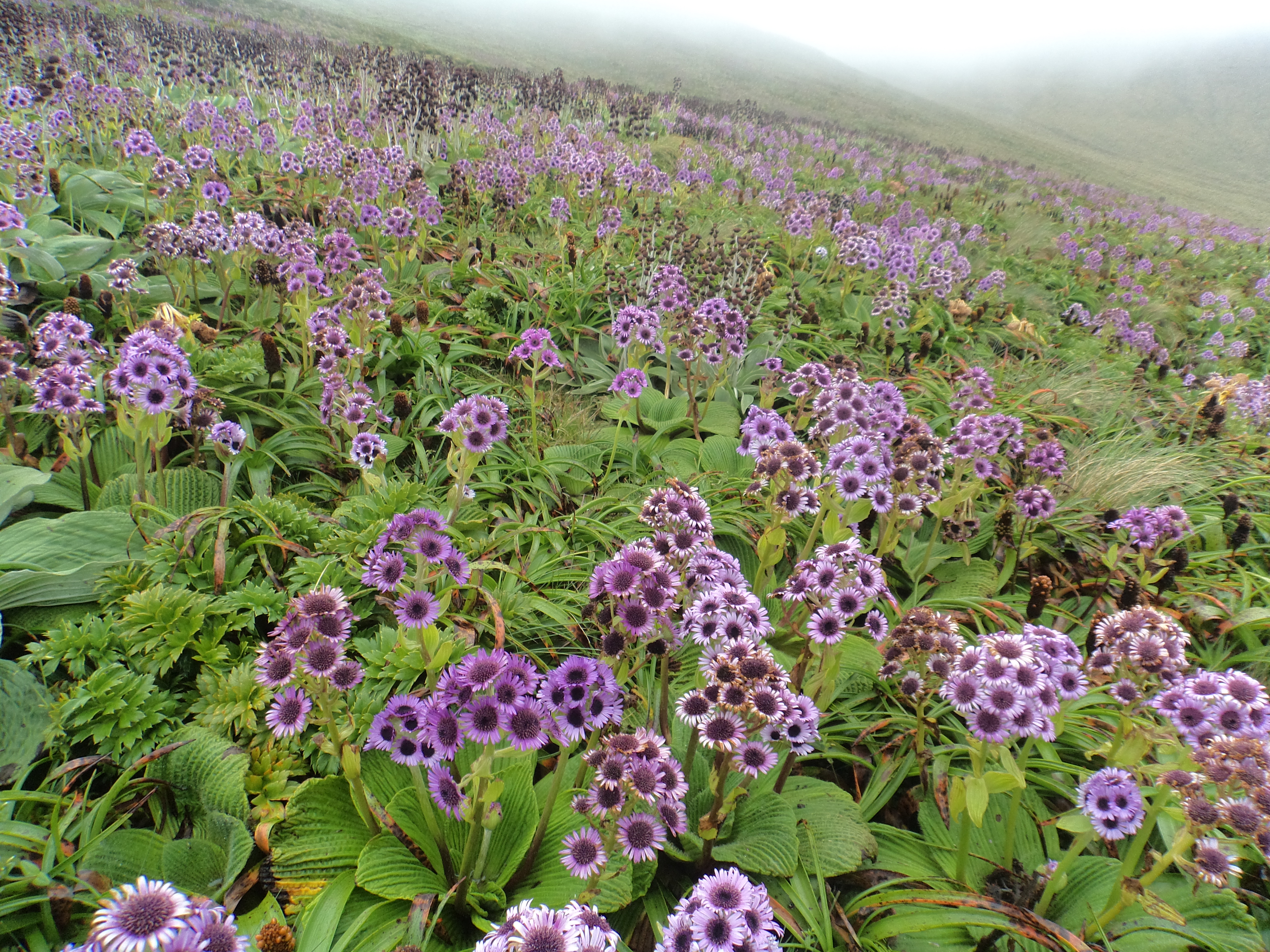
A Black Petrel in the breeding colony on Great Barrier Island, photograph by 'Biz' Bell,Wildlife Management International
The Conservation Services Programme (CSP) of New Zealand’s Department of Conservation works to reduce the impact of commercial fishing on protected species in New Zealand fisheries waters. Here are summaries of two of its most recent final reports by Wildlife Management International on the ACAP-listed and globally Vulnerable Black Petrel Procellaria parkinsoni by the ecological consultancy Wildlife Management International.
Land component
This report is part of the ongoing study of the tākoketai/black petrel, Procellaria parkinsoni, on Great Barrier Island/Aotea that began in the 1995/1996 breeding season.
During the 2021/2022 breeding season 478 tākoketai/black petrel study burrows were intensively monitored within the Mt Hobson/Hirakimata study area on Aotea/Great Barrier Island.
There were 326 (68.2%) burrows occupied by breeding pairs, 92 (19.2%) occupied by non-breeding birds, and 60 (12.6%) were unoccupied. Overall, 239 chicks were produced from the study burrows representing a fledgling success rate of 73.3%.
Nine census grids were monitored within the study area and accounted for 196 of the inspected study burrows. Of these, 148 were occupied by breeding pairs (75.5%) and 102 chicks were produced representing a fledging success rate of 68.9%. A total of 745 adults and 254 fledgling chicks were captured during the 2021/2022 field season with 107 adults banded this season (including 69 from study burrows). Of the 254 fledgling chicks banded during the 2021/2022 field season, 227 were banded in study burrows; 12 had already fledged prior to the banding visit in May 2022.
There have been a total of 386 returned chicks recaptured at the colony since they were banded prior to fledging. Of these, 124 returned chicks identified during the 2021/2022 breeding season; 23 of which had been caught for the first time at the colony. The majority of returned chicks were from the 2013/2014 breeding season, followed by the 2010/2011 cohort). Not all cohorts were represented as no returned chicks from the 1995/1996 and 1996/1997 cohorts were recaptured this season.
Understanding the factors affecting return rates of chicks within the 35-ha study site is vital. It is important to determine whether it is related to low juvenile survival and/or recruitment or if it is simply due to a lack of detection. Understanding juvenile survival and recruitment is necessary for accurate population estimates and risk assessment modelling. Therefore, it is recommended that effort to obtain this data is completed with urgency.
Preliminary monitoring of pig and other predator occurrence and impact on black petrels on Cooper’s Castle was undertaken this season. Sixteen black petrel burrows were identified within the boundaries of this study area; three were breeding and one was being visited by non-breeding birds. All other burrows were empty. Trail cameras were placed along pig pathways, walking tracks and outside active black petrel burrows. Footage confirmed feral pig, rat, and feral cat presence. While no interactions with black petrels were caught on camera, there was one cat predation and one rat predation at the study colony this season. Introduced species still pose a threat to the black petrel population and it is imperative pest control measures continue.
At-sea captures
n January 2022 WMIL staff were only able to undertake a one-day catching trip out in the waters north-east of the Marotere (Chicken) Islands group, and north of the Mokohinau Islands group. Poor weather prevented a longer trip. A total of 17 black petrels were caught from the back of the boat using a hand cast net and were all un-banded birds. Additional species caught were 18 toanui/flesh[1]footed shearwater (Ardenna carneipes) (Threat Status - At Risk: Relict).
In March 2022 WMIL staff were able to undertake a longer three-day catching trip, targeting the same areas, but particularly north of the Mokohinau Islands group. A total of 130 black petrels were caught from the back of a boat using the same hand cast net method. This total included 5 already banded birds from WMIL study colonies on Aotea/Great Barrier Island and Te Hauturu-o-Toi/Little Barrier Island, as well as 3 banded birds from the at-sea capture work. Additional species caught and banded were 78 flesh-footed shearwater, two New Zealand storm petrel (Fregetta maoriana) (Threat Classification: Nationally Vulnerable) and one rako/Buller’s shearwater (Ardenna bulleri) (Threat Classification: At Risk: Declining).
In November 2022 WMIL staff were able to undertake a two-day catching trip, targeting the same areas as previously. A total of 39 black petrels were caught using the hand cast net method. This total included 2 already banded birds from the WMIL study colony on Aotea/Great Barrier Island. Additionally, 30 flesh-footed shearwaters were also caught and banded, one of which was already banded, having been banded at a WMIL study colony on Lady Alice Island in 2017. Finally one ōi/grey[1]faced petrel (Pterodroma gouldi) (Threat Classification: Not Threatened) was also caught and banded.
Over all trips undertaken by WMIL (April 2021, January 2022, March 2022 and November 2022), a total of 383 seabirds were captured altogether (April 2021: n=67, January 2022: n=35, March 2022: n=211, November 2022: n=70). A total of 176 (January 2022: n=17, March 2022: n=122, November 2022: n=37) black petrels were newly banded over all 2022 trips. Including the April 2021 preliminary trial captures, a total of 241 black petrels have been caught over the cumulative 9 days (April 2021: n=55 over 3 days, January 2022: n=17 on 1 day, March 2022: n=130 over 3 days, November 2022: n=39 over 2 days). Of these, 8 were previously banded at a terrestrial colony, representing 3% of total captures. The average daily capture rate of tākoketai/black petrel for each trip is highly variable; 18 per day in April 2021, 17 per day in January 2022, 43 per day in March 2022, and 20 per day in November 2022, with the average daily capture rate of black petrels for all trips being 27. The highest average catches were in the first and last light periods of the day (7-9am and 5-7pm).
Key recommendations for future work are:
- Trips need to be undertaken towards the start of the breeding season, i.e., mid-November through to early February, with several trips throughout the breeding season to allow WMIL staff to capture more birds.
- A large amount of bait should be taken to facilitate creating more feeding frenzies and theoretically more birds behind the back of the boat for capture.
- Future work should be clarified much further in advance to increase the success of this work particularly dealing with ever changing weather and swell conditions, COVID disruptions, moon phases, and aligning the WMIL team and the skipper’s schedules.
- Undertake future work around the dimmest phases of the moon.
- Undertake work further north with either the same skipper (El Pescador Charters) or another suitable vessel (i.e., with a duckboard), to target other areas of this species range.
- Future work should budget for a team of three (minimum) to have flexible flying and accommodation costs, as well as the rising costs of diesel fuel for boat charters and covering the cost of higher bait use.
References:
Bell, E.A., Welch, M. & Lamb, S. 2022. Key demographic parameters and population trends of tākoketai/black petrels (Procellaria parkinsoni) on Aotea/Great Barrier Island: 2021/2022. POP2021-01 final report prepared by Wildlife Management International for the Department of Conservation, Wellington. 35 pp.
Burgin, D. 2022. Summary report for at-sea capture work for tākoketai/black petrels 2022. POP2021-01 final report prepared by Wildlife Management International for the Department of Conservation, Wellington. 18 pp.
Both reports are available from here.
John Cooper, ACAP News Correspondent, 28 December 2022

 English
English  Français
Français  Español
Español 

 Photographs from left to right: A Balearic Shearwater by Pep Arcos; a Grey Petrel chick by Jeremy Bird; a Black-browed Albatross and chick by Ian Strange
Photographs from left to right: A Balearic Shearwater by Pep Arcos; a Grey Petrel chick by Jeremy Bird; a Black-browed Albatross and chick by Ian Strange


 A luxuriant carpet of the megaherb
A luxuriant carpet of the megaherb